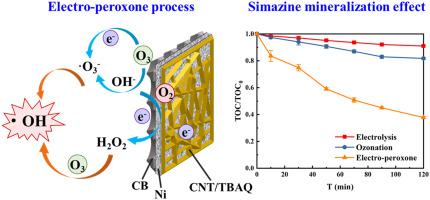当前位置:
X-MOL 学术
›
J. Clean. Prod.
›
论文详情
Our official English website, www.x-mol.net, welcomes your
feedback! (Note: you will need to create a separate account there.)
Synergistic oxidation of simazine in electro-peroxone system with enhanced in-situ electrogenerated H2O2 activity electrode: Performance and mechanism
Journal of Cleaner Production ( IF 9.7 ) Pub Date : 2023-03-28 , DOI: 10.1016/j.jclepro.2023.136967
Xingxing Huang , Yaolong Wang , Wen Xu , Zhiqiang Zhang , Heliang Pang , Jing Yang , Kunyu Chen , Hang Zhao , Jinsuo Lu
Journal of Cleaner Production ( IF 9.7 ) Pub Date : 2023-03-28 , DOI: 10.1016/j.jclepro.2023.136967
Xingxing Huang , Yaolong Wang , Wen Xu , Zhiqiang Zhang , Heliang Pang , Jing Yang , Kunyu Chen , Hang Zhao , Jinsuo Lu

|
Conventional electrocatalytic technology is limited by the efficiency of in-situ electrogenerated HO over the cathode, and the degradability for some pollutants with specific structures is poor. In this study, tert-butyl-anthraquinone modified carbon nanotube electrode (CNT/TBAQ) was used as a cathode to assess the degradation efficiency of pollutants in synergy with O. The surface hydrophobicity of the modified electrode was improved, the proportion of oxygen-containing functional groups was increased by 4.3%, and the catalytically active sites of the material were increased. Compared with electrochemical and ozone technology, the electro-peroxone process could basically achieve complete removal of simazine within 6 min. The TOC removal rate also reached 62.3% after 120 min. Within 90 min, the HO concentration of the CNT/TBAQ cathode reached 583.36 mg/L with current efficiency of 86%. During the electro-peroxone process, the HO produced by electroreduction reacted with ozone to produce a large amount of •OH, which improved the mineralization of pollutants. Degradation intermediates of simazine was identified by LC-MS and detailed transformation pathways was proposed. After 10 cycles, the CNT/TBAQ cathode still maintained a strong ability to produce HO and oxidize pollutants. These results indicate that CNT/TBAQ combined with O oxidation, can improve the pollutant degradation efficiency, providing a promising technology for trace organic pollutant abatement.
中文翻译:

增强型原位电生H2O2活性电极在电-peroxone体系中协同氧化西玛津:性能与机理
传统的电催化技术受到阴极上原位电生成H2O的效率的限制,并且对一些特定结构的污染物的降解能力较差。本研究以叔丁基蒽醌修饰碳纳米管电极(CNT/TBAQ)为阴极,评估与O协同降解污染物的效率。修饰电极的表面疏水性得到改善,氧原子比例提高。含官能团增加4.3%,材料催化活性位点增加。与电化学和臭氧技术相比,电-peroxone工艺基本上可以在6 min内实现西玛嗪的完全去除。 120分钟后TOC去除率也达到62.3%。 90分钟内,CNT/TBAQ阴极的H2O浓度达到583.36 mg/L,电流效率为86%。电过氧化氢过程中,电解还原产生的H2O与臭氧反应生成大量·OH,提高了污染物的矿化作用。通过LC-MS鉴定了西玛嗪的降解中间体,并提出了详细的转化途径。经过10次循环后,CNT/TBAQ阴极仍然保持较强的产生H2O和氧化污染物的能力。这些结果表明,CNT/TBAQ与O氧化相结合,可以提高污染物的降解效率,为痕量有机污染物的减排提供了一种有前景的技术。
更新日期:2023-03-28
中文翻译:

增强型原位电生H2O2活性电极在电-peroxone体系中协同氧化西玛津:性能与机理
传统的电催化技术受到阴极上原位电生成H2O的效率的限制,并且对一些特定结构的污染物的降解能力较差。本研究以叔丁基蒽醌修饰碳纳米管电极(CNT/TBAQ)为阴极,评估与O协同降解污染物的效率。修饰电极的表面疏水性得到改善,氧原子比例提高。含官能团增加4.3%,材料催化活性位点增加。与电化学和臭氧技术相比,电-peroxone工艺基本上可以在6 min内实现西玛嗪的完全去除。 120分钟后TOC去除率也达到62.3%。 90分钟内,CNT/TBAQ阴极的H2O浓度达到583.36 mg/L,电流效率为86%。电过氧化氢过程中,电解还原产生的H2O与臭氧反应生成大量·OH,提高了污染物的矿化作用。通过LC-MS鉴定了西玛嗪的降解中间体,并提出了详细的转化途径。经过10次循环后,CNT/TBAQ阴极仍然保持较强的产生H2O和氧化污染物的能力。这些结果表明,CNT/TBAQ与O氧化相结合,可以提高污染物的降解效率,为痕量有机污染物的减排提供了一种有前景的技术。

































 京公网安备 11010802027423号
京公网安备 11010802027423号